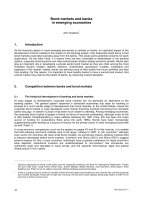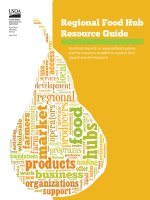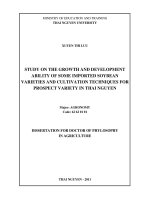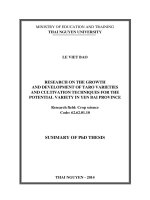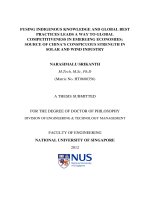Growth and development in emerging economies
Bạn đang xem bản rút gọn của tài liệu. Xem và tải ngay bản đầy đủ của tài liệu tại đây (5.81 MB, 370 trang )
Growth and Development in
Emerging Market Economies
2 HARINDER S. KOHLI
Growth and Development in
Emerging Market Economies
International Private Capital Flows,
Financial Markets and Globalization
Edited by
HARINDER S. KOHLI
Copyright © Harinder S. Kohli, 2008
All rights reserved. No part of this book may be reproduced or utilized in any
form or by any means, electronic or mechanical, including photocopying,
recording or by any information storage or retrieval system, without permission in writing from the publisher.
First published in 2008 by
SAGE Publications India Pvt Ltd
B 1/I-1, Mohan Cooperative Industrial Area
Mathura Road, New Delhi 110044, India
www.sagepub.in
SAGE Publications Inc
2455 Teller Road
Thousand Oaks, California 91320, USA
SAGE Publications Ltd
1 Oliver’s Yard, 55 City Road
London EC1Y 1SP, United Kingdom
SAGE Publications Asia-Pacific Pte Ltd
33 Pekin Street
#02-01 Far East Square
Singapore 048763
Published by Vivek Mehra for SAGE Publications India Pvt Ltd, typeset in
10.5/12.5pt Charter BT by Star Compugraphics Private Limited, Delhi and
printed at Chaman Enterprises, New Delhi.
Library of Congress Cataloging-in-Publication Data
Growth and development in emerging market economies: international
private capital flows, financial markets and globalization/edited by
Harinder S. Kohli.
p. cm.
Includes bibliographical references and index.
1. Capital movements—Developing countries. 2. Investments, Foreign—
Developing countries. 3. Developing countries—Foreign economic relations.
4. Developing countries—Commerce. I. Kohli, Harinder S., 1945–
HG5993.G76
332'.042091724—dc22
ISBN: 978-0-7619-3671-8 (Hb)
2008
2008002359
978-81-7829-837-5 (India-Hb)
The SAGE Team: Sugata Ghosh, Jasmeet Singh, Mathew P.J. and
Trinankur Banerjee.
Contents
List of Tables
List of Figures and Boxes
List of Abbreviations
Foreword
Preface
7
11
19
22
23
1. Introduction and Overview
Harinder S. Kohli
25
2. Global Imbalances, Oil Revenues and Capital Flows
to Emerging Market Countries
Jack Boorman
45
3. Private Capital Flows to Emerging Market Economies:
Major Drivers, Recent Developments and Key Issues
V. Sundararajan and Harinder S. Kohli
81
4. Outward Foreign Direct Investment from Emerging
Economies: New Players in the World Economy?
Heinz Hauser
130
5. Outward Foreign Direct Investment from India
Rakesh Jha
158
6. Building National and Regional Financial Markets:
The East Asian Experience
Andrew Sheng
174
7. Financial Markets in Latin America
Claudio M. Loser
202
8. Latin American and East Asian Trade Strategies
Luis Miguel Castilla
218
6 GROWTH AND DEVELOPMENT IN EMERGING MARKET ECONOMIES
9. Building Asia’s Infrastructure: Issues and Options
Haruhiko Kuroda, Rajat Nag and Rita Nangia
261
10. Infrastructure Development and Services in
Selected Emerging Market and OECD Countries:
Key Indicators
Harpaul Alberto Kohli
282
About the Editor and Contributors
Index
359
363
List of Tables
2.1
2.2
2.3
3.1
3.2
External current account balance (US$ billion)
53
Marginal propensity to import
55
Oil exporting countries: Current account balance
and external financing (US$ billion)
56
Total private capital inflows by region, 1990–2005 85
Index of openness to capital flows for selected
countries
86
3.3
Top 10 countries: Total private capital inflows
89
3.4
Total private capital inflows by type (US$ billion),
1990–2005
90
3.5
Average weighed annual GDP growth rates (%) 100
3A(2)1 Real effective exchange rate by region (weighed
by GDP)
115
3A(2)2 Foreign direct investment by region (US$ billion),
1990–2005
115
3A(2)3 Portfolio capital inflows (debt plus equity) by
region (US$ billion), 1990–2005
116
3A(2)4 Portfolio equity inflow by region (US$ billion),
1990–2005
117
3A(2)5 Portfolio debt by region (US$ billion), 1990–2005 118
3A(2)6 Net flow of bank financing by region
(US$ billion), 1990–2005
119
3A(2)7 Top 10 countries: Total FDI inflows into EMEs
(US$ billion)
120
3A(2)8 Top 10 countries: Total portfolio inflows into
EMEs (US$ billion)
120
3A(2)8a Top 10 countries: Debt inflows into EMEs
(US$ billion)
121
3A(2)8b Top 10 countries: Equity inflows into EMEs
(US$ billion)
121
3A(2)9 Top 10 countries: Net banks flows into EMEs
(US$ billion)
122
8 GROWTH AND DEVELOPMENT IN EMERGING MARKET ECONOMIES
3A(2)10 Total capital inflows, long-term trend (average,
US$ billion)
3A(2)11 Total capital inflows, long-term trend
(% of GDP)
3A(2)12 Capital inflows by type, long-term trend
(average, US$ billion)
3A(2)13 Capital inflows by type, long-term trend, period
averages (% of GDP)
3A(2)14 Foreign direct investment, long-term trend
(average, US$ billion)
3A(2)15 Foreign direct investment, long-term trend,
period averages (% of GDP)
3A(2)16 Total portfolio inflows, long-term trend
(average, US$ billion)
3A(2)17 Total portfolio inflows, long-term trend, period
averages (% of GDP)
3A(2)18 Equity inflows, long-term trend (average,
US$ billion)
3A(2)19 Equity inflows, long-term trend, period average
(% of GDP)
3A(2)20 Debt inflows, long-term trend (average,
US$ billion)
3A(2)21 Debt inflows, long-term trend, period averages
(% of GDP)
3A(2)22 Net bank flows, long-term trend (average,
US$ billion)
3A(2)23 Net bank flows, long-term trend, period
averages (% of GDP)
4.1
4.2
4.3
5.1
5.2
5.3
122
122
123
123
124
124
124
125
125
125
126
126
127
127
South–South FDI as a share of global FDI to
developing countries (US$ billion)
136
Outward FDI performance index, based on FDI
stocks, average 2003–05
141
The Boston Consulting Group list of top emerging
global challengers
144
Phases in the evolution of OFDI in India
160
Outward FDI from India (US$ million)
162
Industry-wise distribution of approved outward
FDI flows (US$ million)
165
List of Tables
5.4
5.5
6.1
6.2
6.3
Major overseas acquisitions by Indian firms in
FY 2007
167
Country-wise approved Indian direct investment
in Joint Ventures (JVs) and Wholly Owned
Subsidiary (WOS) (US$ million)
168
Asian intra-regional trade (as % of total
world trade)
Financial structure in selected countries, 1990
and 2004 (% of GDP)
Indicators on quality of financial infrastructure
(0 to 10 scale, higher is better)
7.1
7.2
7.3
Indicators of capital market size (US$ trillion)
Bank assets (US$ trillion and as % of GDP)
Selected Latin American countries: Structure of
banking systems
8.1
8.2
Average tariff by type of goods and by region (%)
Participation in manufactured exports and
manufactured value-added goods by regions,
1980 versus 1997
Typology of intra-regional trade by trading blocs
(% of total intra-industrial trade)
Average tariffs per region (%), 1980–99
Trade openness by decade (%)
Trade flows between East Asia and Latin America
(US$ million)
Latin American trade balance with East Asia
(US$ million)
Percentage of Latin American exports to
East Asia, by product, 2004
Percentage of Latin American imports from
East Asia, by product, 2004
Main Chinese imports and suppliers
8.3
8.4
8.5
8.6
8.7
8.8
8.9
8.10
9.1
9.2
9
Importance of intra-regional trade in Asia
(% of total trade)
Increasing share of Asia in the World (%)
176
178
191
204
205
208
227
231
232
234
234
245
246
247
248
250
262
264
10 GROWTH AND DEVELOPMENT IN EMERGING MARKET ECONOMIES
9.3
9.4
9.5
9.A1
10.1
10.2
10.3
Infrastructure indicators—Selected Asian
countries
Private infrastructure in developing Asia
Infrastructure investments requirements,
2006–15
Infrastructure reforms indicators as of 2004
Key infrastructure indicators for selected
EMCs, 2003–04
Key infrastructure indicators for selected
EMCs, 1990
Key infrastructure indicators for selected
EMCs, 1980
267
269
272
279
290
295
299
List of Figures and Boxes
Figures
2.1
2.2
2.3
2.4
2.5
2.6
2.7
2.8
2.9
2.10
2.11
2.12
2.13
2.14
2.15
2.16
United States: External current account balance
and overall fiscal balance (% of GDP)
United States: External current account balance
and net household savings (% of GDP)
External current account balance (US$ billion)
Imports from United States (as a share of total
imports)
Oil exporting countries from the Middle East and
Central Asia: Overall fiscal balance and public
spendings (% of GDP)
External current account balance (% of GDP)
Gross international reserves (US$ billion)
Major foreign holders of treasury securities
(holdings at the end of period, in US$ billion)
Gross external loans and deposits of BIS-reporting
banks and oil prices
Net external loans and deposits of BIS-reporting
banks (US$ billion)
Total capital flows to emerging market countries,
1990–2004 (US$ billion)
Total capital flows to emerging market countries,
1990–2004 (US$ billion)
Emerging market countries: Overall fiscal balance
and total international reserves
Number of sovereign upgrades/downgrades and JP
Morgan emerging market global sovereign spread
1990–2005 (by Moody’s, S&P and Fitch Ratings,
including changes to positive/negative outlooks)
Emerging market countries: External debt and
debt services (% of GDP)
Selected emerging market countries:
Stock market indices
48
49
51
55
57
58
59
61
63
65
67
67
69
70
71
74
12 GROWTH AND DEVELOPMENT IN EMERGING MARKET ECONOMIES
3.1
3.2
3.3
3.4
3.5
3.6
3.7
3.8
3.9
Total capital flows into EMEs (US$ billion)
Capital flows into emerging markets, by type
(US$ billion)
Total capital inflows as per cent GDP, by
emerging market region (US$ billion)
Foreign direct investment (US$ billion)
Total portfolio (US$ billion)
Equity (US$ billion)
Debt (US$ billion)
Banks (Net, US$ billion)
Global Sukuk
87
87
88
91
92
93
94
95
111
4.1
4.2
4.3
Outward FDI of selected emerging economies
Outward FDI as a percentage of inward FDI
FDI outflows from developing economies, and
Southeast Europe and CIS (US$ billion)
134
6.1
Poverty in Asia
175
7.1
Latin America: Financial liberalization
(index 0 to 1)
Financial liberalization (including capital account
and domestic financial markets)
7.2
8.1
8.2
8.3
8.4
8.5
8.6
8.7
8.8
8.9(a)
131
132
206
206
Income convergence/divergence, 1950–2000
Average TFP growth in Latin America
TFP growth in selected countries, 1990–2000
Exports performance
Share of world exports
Performance of manufacturing and exports
Comparative advantages
Herfindahl index for export concentration
Latin American import from East Asia, by
countries, 2004
8.9(b) Latin American export from East Asia, by
countries, 2004
221
222
223
225
225
228
228
230
9.1
Selected infrastructure indicators
266
10.1
Population (million)
285
244
244
10.2
10.3
10.4
10.5
10.6
10.7
10.8
10.9
10.10
10.11
10.12
10.13
10.14
10.15
10.16
10.17
10.18
10.19
10.20
10.21
10.22
10.23
10.24
10.25
10.26
10.27
10.28
10.29
10.30
10.31
List of Figures and Boxes
13
Population (million)
GDP (US$ trillion constant 2000)
GDP (US$ trillion constant 2000)
GDP PPP (US$ trillion current)
GDP (US$ trillion constant 2000)
GDP PPP share of World total (%)
GDP PPP share of World total (%)
GDP PPP per capita (US$)
GDP PPP per capita (US$)
Brazil key infrastructure indicators
China key infrastructure indicators
India key infrastructure indicators
Indonesia key infrastructure indicators
Malaysia key infrastructure indicators
Mexico key infrastructure indicators
Turkey key infrastructure indicators
Energy use (kg of oil equivalent per capita)
Energy use (kg of oil equivalent per capita)
Energy use per GDP (kg of oil equivalent
per US$ constant 2000)
Energy use per GDP (kg of oil equivalent
per US$ constant 2000)
Energy use per PPP GDP (kg of oil equivalent
per US$ constant 2000 PPP)
Energy use per PPP GDP (kg of oil equivalent
per US$ constant 2000 PPP)
GDP PPP per unit of energy use
(kg of oil equivalent per US$ constant 2000)
Energy use per PPP GDP (kg of oil equivalent
per US$ constant 2000 PPP)
Energy production (thousand kT of oil equivalent)
Energy production (thousand kT of oil equivalent)
Energy imports, net (% of commercial
energy use)
Energy imports, net (% of commercial
energy use)
Pump price for super gasoline per liter (US$)
Pump price for super gasoline per liter (US$)
285
286
286
287
287
288
288
289
289
302
302
303
303
304
304
305
305
306
306
307
307
308
308
309
309
310
310
311
311
312
14 GROWTH AND DEVELOPMENT IN EMERGING MARKET ECONOMIES
10.32 Electric power consumption per capita (kWh)
10.33 Electric power consumption per capita (kWh)
10.34 Electric power consumption per GDP
(kWh per const 2000 GDP)
10.35 Electric power consumption per GDP (kWh)
10.36 Electricity production (kWh)
10.37 Electricity production (kWh trillion)
10.38 Electricity production from oil sources
(% of total)
10.39 Electricity production from oil sources
(% of total)
10.40 Electricity production from nuclear sources
(% of total)
10.41 Electricity production from nuclear sources
(% of total)
10.42 Electric power transmission and distribution
losses (% of output)
10.43 Electric power transmission and distribution
losses (% of output)
10.44 Electricity (% managers surveyed ranking
this as a major constraint) 2003
(2004 for Indonesia & 2005 for Turkey)
10.45 Electricity (% managers surveyed ranking
this as a major constraint) 2005
10.46 Roads, goods transported (billion ton/km)
10.47 Roads, goods transported (billion ton/km)
10.48 Roads, goods transported per GDP
(ton/km per US$ thousand constant 2000)
10.49 Roads, goods transported per GDP
(ton/km per US$ thousand constant 2000)
10.50 Roads, total network (km million)
10.51 Roads, total network (km million)
10.52 Roads, paved (% of total roads)
10.53 Roads, paved (% of total roads)
10.54 Rail lines (thousand route/km)
10.55 Rail lines (thousand route/km)
10.56 Railways, goods hauled (trillion ton/km) 2002
(2003 for Indonesia, Malaysia)
312
313
313
314
314
315
315
316
316
317
317
318
318
319
319
320
320
321
321
322
322
323
323
324
324
List of Figures and Boxes
10.57 Railways, goods hauled (ton/km) 2002
(Chile 2003)
10.58 Railways, goods hauled per GDP
(ton/km per US$ thousand constant 2000) 2002
(2003 for Indonesia, Malaysia)
10.59 Railways, goods hauled per GDP
(ton/km per US$ thousand constant 2000) 2002
(2003 for Chile)
10.60 Railways, passengers carried (billion passenger/km)
2002 (2003 for Indonesia)
10.61 Railways, passengers carried
(billion passengers/km)
10.62 Railways, passengers carried per GDP
(passengers/km per US$ thousand constant 2000)
2002 (2003 for Indonesia)
10.63 Container port traffic (TEU: 20 foot equivalent
units)
10.64 Container port traffic (TEU: 20 foot equivalent
units)
10.65 Container port traffic per GDP
(TEU per US$ million constant 2000)
10.66 Container port traffic per GDP
(TEU per US$ million constant 2000)
10.67 Average time to clear customs (days) 2003
(Turkey 2005; Indonesia 2004)
10.68 Average time to clear customs (days) 2005
(Brazil & India are 2003)
10.69 Air transport, million passengers carried
10.70 Air transport, million passengers carried
10.71 Air transport, passengers carried per GDP
(per US$ million constant 2000)
10.72 Air transport, passengers carried per GDP
(per US$ million constant 2000)
10.73 Aircraft departures
10.74 Aircraft departures
10.75 Air transport, freight (million ton/km)
10.76 Air transport, freight (million ton/km)
15
325
325
326
326
327
327
328
328
329
329
330
330
331
331
332
332
333
333
334
334
16 GROWTH AND DEVELOPMENT IN EMERGING MARKET ECONOMIES
10.77 Air transport, freight per GDP
(million ton/km per US$ constant 2000)
10.78 Air transport, freight per GDP
(ton/km per US$ thousand constant 2000)
10.79 Improved water source
(% of population with access) 2002
10.80 Improved water source
(% of population with access)
10.81 Improved water source, rural
(% of rural population with access) 2002
10.82 Improved water source, rural
(% of rural population with access)
10.83 Improved water source, urban
(% of urban population with access) 2002
10.84 Improved water source, urban
(% of urban population with access)
10.85 Improved sanitation facilities
(% of population with access) 2002
10.86 Improved sanitation facilities
(% of population with access)
10.87 Improved sanitation facilities, rural
(% of rural population with access) 2002
10.88 Improved sanitation facilities, rural
(% of rural population with access)
10.89 Improved sanitation facilities, urban
(% of urban population with access) 2002
10.90 Improved sanitation facilities, urban
(% of urban population with access)
10.91 Telephone mainlines per GDP
(per US$ million constant 2000)
10.92 Telephone mainlines per GDP
(per US$ million constant 2000)
10.93 Fixed line and mobile phone subscribers
per GDP (per US$ million constant 2000)
10.94 Fixed line and mobile phone subscribers
per GDP (per US$ million constant 2000)
10.95 Fixed line and mobile phone subscribers
(per 1,000 people) 2005
335
335
336
336
337
337
338
338
339
339
340
340
341
341
342
342
343
343
344
List of Figures and Boxes
10.96
10.97
10.98
10.99
10.100
10.101
10.102
10.103
10.104
10.105
10.106
10.107
10.108
10.109
10.110
10.111
10.112
10.113
10.114
10.115
10.116
10.117
10.118
10.119
Fixed line and mobile phone subscribers
(per 1,000 people)
Telephone mainlines (per 1,000 people) 2005
Telephone mainlines (per 1,000 people)
Telephone mainlines, waiting list (million people)
Telephone mainlines, waiting list (million people)
Telephone faults (per 100 mainlines)
Telephone faults (per 100 mainlines)
Mobile phones (per 1,000 people) 2005
Mobile phones (per 1,000 people)
Mobile phones per GDP (per US$ million
constant 2000)
Mobile phones per GDP (per US$ million
constant 2000)
Telephone average cost of local call (US$ per
three minutes)
Telephone average cost of local call (US$ per
three minutes)
Telephone average cost of call to US (US$ per
three minutes)
Telephone average cost of call to US (US$ per
three minutes)
Internet users per GDP (per US$ thousand
constant 2000)
Internet users per GDP (per US$ thousand
constant 2000)
Personal computers (per 1,000 people)
Personal computers (per 1,000 people)
Personal computers per GDP (per US$ million
constant 2000)
Personal computers per GDP (per US$ million
constant 2000)
Internet total monthly price (US$ per 20 hours
of use) 2003
Internet total monthly price (US$ per 20 hours
of use) 2003
Internet users (per 1,000 people)
17
344
345
345
346
346
347
347
348
348
349
349
350
350
351
351
352
352
353
353
354
354
355
355
356
18 GROWTH AND DEVELOPMENT IN EMERGING MARKET ECONOMIES
10.120 Internet users (per 1,000 people)
10.121 Private investment in energy (US$ billion at
current rate)
10.122 Private investment in telecoms (US$ billion at
current rate)
10.123 Private investment in transport (US$ billion at
current rate)
10.124 Private investment in water and sanitation
(US$ billion at current rate)
356
357
357
358
358
Boxes
3.1 Global imbalances, risk aversion and recent
turbulence in emerging markets
3.2 Middle-East surpluses and Islamic securities
102
105
5.1 Selected changes to Indian overseas investment
policy
170
List of Abbreviations
AAOIFI
Accounting and Auditing Organization for Islamic
Financial Institutions
ADRs
American Depository Receipts
AFTA
Asian Free Trade Agreement
ALADI
Asociación Latinoamericana de Integración
AREAER Annual Report on Exchange Arrangements and
Exchange Restrictions
ASEAN Association of Southeast Asian Nations
BCG
Boston Consulting Group
BCIE
Banco Centroamericano de Integración Económica
BIS
Bank for International Settlement
BITs
Bilateral Investment Treaties
BPO
Business Process Outsourcing
BRIC
Brazil, Russia, India and China
CACM
Central American Common Market
CAF
Corporacion Andina de Fomento
CIMC
China International Marine Containers Group
Company
CMI
Chiang Mai Initiative
CNC
China Netcom Group Corporation
CNHTC China National Heavy Truck Group Corporation
CVRD
Companhia Vale do Rio Doce
DDA
Doha Development Program
DJIMI
Dow Jones Islamic Market Indexes
DRs
Depositary Receipts
DTTs
Double Taxation Treaties
ECBs
External Commercial Borrowings
ECLAC
Economic Commission for Latin America and the
Caribbean
EEFA
Exchange Earners Foreign Currency Account
EMBI
Emerging Market Bond Index
EMCs
Emerging Market Countries
20 GROWTH AND DEVELOPMENT IN EMERGING MARKET ECONOMIES
EMEs
EU
FCCBs
FDI
FPI
FSAF
FSAP
FTAA
FTSE
FY
GATT
GDF
GDP
GDR
GOI
IDB
IFIs
IFS
IIFS
IMF
INR
IOSCO
IT
JVs
LAC
LDCs
M&A
MISC
MNEs
MTS
MYR
NAC
NAFTA
NGOs
n.i.e
ODA
OECD
Emerging Market Economies
European Union
Foreign Currency Convertible Bonds
Foreign Direct Investment
Foreign Portfolio Investment
Financial Stability Assessment Framework
Financial Sector Assessment Program
Free Trade Area of the Americas
Financial Times Stock Exchange
Fiscal Year
General Agreement on Tariffs and Trade
Global Development Finance
Gross Domestic Product
Global Depository Receipt
Government of India
Islamic Development Bank
International Financial Institutions
International Financial Statistics
Institutions offering Islamic Financial Services
International Monetary Fund
Indian Rupees
International Organization of Securities Commission
Information Technology
Joint Ventures
Latin America and Caribbean
Least Developed Countries
Mergers and Acquisitions
Malaysia International Shipping Company
Multinational Enterprises
Mobile Telesystems
Malaysian Ringgit
Nanjing Automobile Group Corporation
North American Free Trade Agreement
Non-Governmental Organizations
not included elsewhere
Official Development Assistance
Organisation for Economic Co-operation and
Development
List of Abbreviations
OFDI
ONGC
PPPs
PRC
PSIA
RBI
RED
RMB
RTAs
S&P
SAIC
SEZs
SFC
SITC
SPVs
TCS
TFP
TIC
TNCs
TSR
UAE
UNCTAD
VSNL
WBCSD
WDI
WEO
WTO
21
Outward Foreign Direct Investment
Oil and Natural Gas Corporation Limited
Public–Private Partnerships
Peoples Republic of China
Profit Sharing Investment Accounts
Reserve Bank of India
Reporte de Economía y Desarrollo
Renminbi
Regional Trade Agreements
Standard and Poor’s
Shanghai Automotive Industry Corporation
Special Economic Zones
Securities and Futures Commission
Standard International Trade Classification
Special Purpose Vehicles
Tata Consultancy Services
Total Factor Productivity
Treasury International Capital
Transnational Corporations
Total Shareholder Return
United Arab Emirates
United Nations Conference on Trade and
Development
Videsh Sanchar Nigam Limited
World Business Council for Sustainable Development
World Development Indicators
World Economic Outlook
World Trade Organization
22 HARINDER S. KOHLI
Foreword
T
his book is a valuable addition to the literature on prospects
and challenges common to the better performing medium and
low income developing countries—commonly referred to as the
Emerging Market Economies (EMEs)—be they in Asia, Europe,
Latin America or Africa. These countries have become concrete
examples of the historic success of the international development
community during the past 50 years in significantly improving
the social and economic well being of a very large number of
human beings throughout the world.
Private capital flows have now become the primary source
of foreign capital in well-performing developing countries.
Most observers expect this trend to continue. Thus, further
development of EMEs and private capital flows have become
much more intertwined than ever before.
The Emerging Markets Forum that commissioned the papers
included in this volume is devoted to exploring common
opportunities, challenges and risks, and also forging a consensus
between the key decision makers in the public and private sectors
on how best to sustain and build on the successes of these EMEs.
The book is unique in the sense that it comprises of chapters
written by authors with world wide reputation in their
respective fields as well as actual experience with high policy
making around the world. As a result, its policy-analysis and
proposals are grounded in reality of practical policy-making and
implementation under a variety of country circumstances.
I congratulate the book’s editor Harinder S. Kohli and other
authors who deserve our sincere thanks for producing uniformly
outstanding chapters. I know it has been a labour of love for
each one of them. The end product is an excellent book that I
can commend highly to all those interested in EMEs.
Gautam S. Kaji
Chairman, Advisory Board
Emerging Markets Forum
Preface
I
n the past decade, there has been a dramatic rise in private
capital flows to Emerging Market Economies (EMEs). Until
the 1990s, most private capital flows were concentrated in a
few countries, mainly in Asia and Latin America. But, in the past
few years, a much larger number of developing countries have
become recipients of substantial private capital flows both in
absolute terms and relative to their gross national product. At the
same time, net capital flows from official sources—multilateral
and bilateral financial institutions such as the International
Monetary Fund, World Bank and regional development banks,
the European Union (EU) as well as national aid agencies—
have dropped significantly since 1998, except to Sub-Saharan
Africa.
The Emerging Markets Forum was started in 2005 in
recognition of this new reality in the development process. The
Forum’s basic objective is to bring together high-level government
officials and corporate leaders from around the world for an
informal, private and intimate dialogue on the key economic,
financial and social issues facing EMEs. The Forum is focussed
on some 50 EMEs mostly in Asia, Europe and Latin America (plus
some countries in the Middle East and Sub-Saharan Africa),
which are keen to integrate with the global economy, already
have or seek to create a conducive business environment, and
are of near-term interest to private investors, both domestic and
international. The Forum seeks to promote knowledge sharing,
policy guidance and private sector engagement that will facilitate
achievement of their common goal of sustainable growth and
development.
This volume starts with an overview chapter, and comprises
nine papers presented at the 2006 Global Meeting of the Forum
held in Jakarta, Indonesia, in September 2006. The theme of this
meeting was International Capital Flows and Domestic Capital
24 GROWTH AND DEVELOPMENT IN EMERGING MARKET ECONOMIES
Markets: Growth and Development in Emerging Markets. The
papers sparked a rich and intellectually stimulating debate among
the senior policy makers, business executives and leading thinkers
at the meeting. The participants recommended that, given the
high quality of the papers and the wide interest in the topics
covered, they should be made available to a larger audience.
This book is in response to this recommendation. The papers
have been revised in light of the discussion at Jakarta.
I would like to thank the authors for the time and effort
they have put in the preparation of the papers. In the order in
which their papers appear in this book, they are: Jack Boorman;
V. Sundararajan (my co-author); Heinz Hauser; Rakesh Jha;
Andrew Sheng; Claudio M. Loser; Luis Miguel Castilla; Haruhiko
Kuroda, Rajat Nag and Rita Nangia; and Harpaul Alberto Kohli.
The authors are all renowned authorities in their respective
fields and we were most fortunate to obtain their agreement to
share their experience and views by preparing these papers and
participating in Forum discussions.
Special thanks are due to my advisor and dear friend Bimal
Jalan for inspiring this book, and to Sugata Ghosh, Jasmeet Singh
and their colleagues at SAGE Publications for their help, patience
and guidance throughout. I would also like to express my
sincere appreciation to my colleagues at the Emerging Markets
Forum, Gautam S. Kaji and P.R. Narvekar, for their support and
encouragement. Finally, I owe a special debt to Yanbei Yao and,
my son and professional colleague, Harpaul Alberto Kohli, for
their collaborative efforts, hard work and dedication in getting
this manuscript ready for publication.
Harinder S. Kohli
Chief Executive
Emerging Markets Forum
